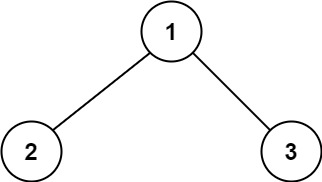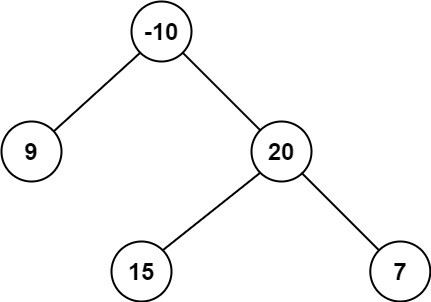
A path in a binary tree is a sequence of nodes where each pair of adjacent nodes in the sequence has an edge connecting them. A node can only appear in the sequence at most once. Note that the path does not need to pass through the root.
The path sum of a path is the sum of the node’s values in the path.
Given the root of a binary tree, return the maximum path sum of any path.
1
2
3
4
5
| Example 1:
Input: root = [1,2,3]
Output: 6
Explanation: The optimal path is 2 -> 1 -> 3 with a path sum of 2 + 1 + 3 = 6.
|

1
2
3
4
5
| Example 2:
Input: root = [-10,9,20,null,null,15,7]
Output: 42
Explanation: The optimal path is 15 -> 20 -> 7 with a path sum of 15 + 20 + 7 = 42.
|

Constraints:
- The number of nodes in the tree is in the range [1, 3 * 104].
- -1000 <= Node.val <= 1000
Solution#
1
2
3
4
5
6
7
8
9
10
11
12
13
14
15
16
17
18
19
20
21
22
23
24
25
26
27
28
29
30
31
32
33
34
35
36
37
38
| /**
* Definition for a binary tree node.
* public class TreeNode {
* int val;
* TreeNode left;
* TreeNode right;
* TreeNode() {}
* TreeNode(int val) { this.val = val; }
* TreeNode(int val, TreeNode left, TreeNode right) {
* this.val = val;
* this.left = left;
* this.right = right;
* }
* }
*/
class Solution {
int maxSum = 0;
public int maxPathSum(TreeNode root) {
maxSum = root.val;
dfs(root);
return maxSum;
}
int dfs(TreeNode node) {
if (node == null) return 0;
int leftSum = Math.max(dfs(node.left), 0);
// int leftSum = dfs(node.left);
int rightSum = Math.max(dfs(node.right), 0);
// int rightSum = dfs(node.right);
int currSum = leftSum + node.val + rightSum;
maxSum = Math.max(currSum, maxSum);
return node.val + Math.max(leftSum, rightSum);
}
}
|
Solution 2021-11-22#
1
2
3
4
5
6
7
8
9
10
11
12
13
14
15
16
17
18
| class Solution {
int max;
public int maxPathSum(TreeNode root) {
if (root == null) return 0;
max = root.val;
maxSum(root);
return max;
}
int maxSum(TreeNode node) {
if (node == null) return 0;
int leftSum = Math.max(maxSum(node.left), 0); // either take left or not
int rightSum = Math.max(maxSum(node.right), 0); // either take right or not
int currMax = leftSum + rightSum + node.val;
max = Math.max(max, currMax);
return node.val + Math.max(leftSum, rightSum);
}
}
|
Solution 2022-01-30#
1
2
3
4
5
6
7
8
9
10
11
12
13
14
15
16
17
18
19
20
21
22
23
24
25
26
27
28
29
30
31
32
33
34
35
| /**
* Definition for a binary tree node.
* public class TreeNode {
* int val;
* TreeNode left;
* TreeNode right;
* TreeNode() {}
* TreeNode(int val) { this.val = val; }
* TreeNode(int val, TreeNode left, TreeNode right) {
* this.val = val;
* this.left = left;
* this.right = right;
* }
* }
*/
class Solution {
int maxSum = 0;
public int maxPathSum(TreeNode root) {
maxSum = root.val;
dfs(root);
return maxSum;
}
int dfs(TreeNode node) {
if (node == null) return 0;
int left = Math.max(dfs(node.left), 0);
int right = Math.max(dfs(node.right), 0);
int currSum = node.val + left + right;
maxSum = Math.max(maxSum, currSum);
return node.val + Math.max(left, right);
}
}
|

